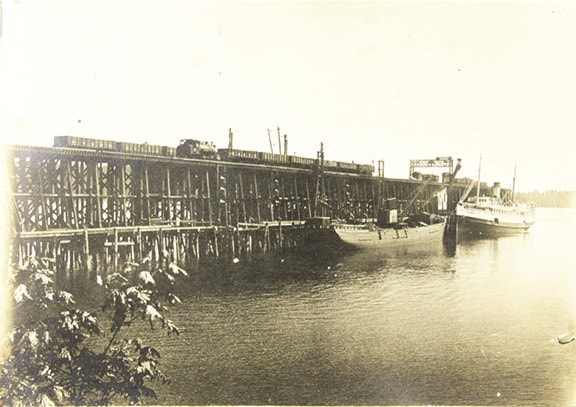400-foot-long bunkers capable of holding 8,000 tons of coal at a time were built with chutes at each end which would discharge into waiting railcars for loading aboard ships.
Much of Ladysmith’s prime waterfront has, in a sense, come full circle over the past century and more: from forest to industry to parkland.
On a sunny winter morning 25 years ago, Transfer Beach Park was alive with people walking their dogs, jogging and birdwatching. But it was Ladysmith’s black past — coal mining — that drew me and my guide, Ladysmith’s late resident historian, Ray Knight.
Long gone is the day when Ladysmith (originally Oyster Harbour) lived off the avails of Extension coal. For years, the Dunsmuir family had grown rich on its famous Wellington coal seam north of Nanaimo; by the turn of the last century, however, the famous Wellington mines were giving out and brothers James and Alex were worried. Ephraim “Edward” Hodgson, a mysterious character, proved to be their salvation in 1895 with his discovery of a coal outcropping on the southern slope of Mount Benson, seven miles southeast of Nanaimo.
As the surface seam lay within the Dunsmuirs’ vast E&N Railway land grant, Hodgson informed James of his find which, he claimed, had been exposed by a fallen tree. (Now there’s a story for a future column.) Mining engineers verified Hodgson’s outcropping to be of excellent quality, worthy of development; an extension, in fact, of the Wellington Seam.
Originally, the Dunsmuirs planned to haul coal from the proposed “Extension” Mine to their wharving facilities at Departure Bay. But a competing colliery company barred them from building the required railway right-of-way across their holdings (in retaliation for James’ having done the same to them, years previously).
James rerouted the railway line to a bay 15 miles south of Nanaimo and 10 miles, by rail, southeast of Extension. Accessible to deepsea shipping, Oyster Harbour lay on the E&N mainline and offered the Dunsmuirs an ideal shipping terminus for Extension’s bituminous coal which was already being stockpiled. Four hundred-foot-long bunkers capable of holding 8,000 tons of coal at a time were built with chutes at each end which would discharge into waiting railcars for loading aboard ships.
Inevitably, such development required living accommodations for the workers; thus, late in 1897, with James’s encouragement because he didn’t want his miners to reside at Extension, the birth of Oyster Harbour townsite, the future Ladysmith.
The dockside bunkers gave the Dunsmuirs an opportunity for an Island “first”: besides transferring coal to ships, loaded rail cars could be transported to the mainland by barge. Thus what was to become known as the quadri-tracked Transfer Wharf was built to connect Extension coal — up to 400,000 tons annually — to Vancouver.
By this time, too, Mount Sicker copper ore was being shipped to Tacoma, Wash. for smelting via the E&N and Canadian Pacific Railway at Ladysmith. The 12-car barge Transfer, built to haul Union Bay coke to Vancouver, went into service with the steam tug Czar as her tender.
E&N chronicler Donald MacLachlan has termed Ladysmith’s transfer facility “a fulfilment of destiny” for the Island railway. Up until this time heavy goods and equipment had been lightered to the Island. Ladysmith became more than a satellite to Extension; its railway barge system directly linked Vancouver Island, in effect, with all of North America.
The CPR’s bigger, heavier cars made problems for its junior partner but the system worked well and was expanded to seven days a week. Traffic grew to the point that a full-time yard switching crew had to be established at Ladysmith to channel passengers and freight trains loaded with Extension coal, Mount Sicker copper, Shawnigan Lake lumber, Esquimalt canned goods and general merchandise, as well as that arriving from the mainland.
In 1905 the CPR acquired the E&N. The Transfer Wharf continued in service until 1955 when all rail-barge freight was redirected through new facilities at Nanaimo. By then, Ladysmith’s reliance upon the Extension coal mines was long a matter of history, having ended in 1929. Previously, the city’s “T-Wharf” and the great coal dock with its cavernous bunkers had been demolished — cut up and burned as firewood.
The Transfer Wharf, its distinctive twin towers and cross-bar by which its loading ramp could be raised or lowered to accommodate the tides, sat idle until it was razed in the ’70s. During demolition, Ray Kight recalled, the severed towers, their winch wheels a-drag, drifted about Ladysmith Harbour for days.
www.twpaterson.com
